The Halton County Radial Railway Museum:
In many of my trip reports, I have made reference to the Halton County Radial Railway Museum in Rockwood, Ontario. This page shows some of the cars they have.
First are former Toronto Gloucester class subway cars 5098-5099. These cars were the reason I found out about the museum because I heard the TTC was donating two cars to the museum though they had to install a trolley pole to allow the cars to run under overhead wires.

In December of 2007, some vandals graffitied the cars. However, museum volunteers painted over most of the graffiti. The cars were in need of paint anyway, though once they build a new car barn, they plan to give 5098-5099 a paint job.

Next is car 1326. The museum was founded to save it from being scrapped in 1954; the same year the Gloucesters were new. In 2010, car 1326 turned 100 years old.

Next is former Toronto Large Witt #2424. 2424 is the only operational Toronto large Witt in existence. HCRR also has large Witt #2984 which they acquired as a body only. 2424 is one of the more frequently used cars.

Next is small with #2894 (not to be confused with large Witt 2984). I have had the opportunity to operate the car in spring of 2002.

HCRR also has small Witt #2786 which is in need of a major overhaul. #2786 is similar to Witt #2894 but was built by Canadian Car and Foundry while #2894 was built by the Ottawa Car Company. #2786 represents the Witts when they retired while #2894 was restored to how it looked in 1937.

In
2025 the TTC sent #2786’s sister car #2766 to

Next is London and Port Stanley interurban #8. Car #8 has been beautifully restored and is used often. 8 is also the only operational piece of London and Port Stanley equipment in existence.

In late 2009/early 2010, HCRR acquired a CP wooden caboose. In summer of 2010, it was restored and run behind L&PS 8 and rides are available for a premium fare.

In 2012,
HCRR acquired

I had eaten
at the Ossawippi Dining Express on my 2008

In late
November or early December of 2011, HCRR learned of a

Next is former Chicago Transit Authority el car #48. Car 48 is a PCC type el car and was similar to equipment that the TTC was considering for the subway prior to going with the Gloucester car design. Car 48 is the first piece of rolling stock acquired from a U.S. property and is often called “the Amtrak car” because it looks like Amtrak’s Phase 3 livery.

One of the more popular cars in the
summertime is open car #327. 327 was built in 1934 to the blueprints of an 1893
car design. In 1972, 327 became the first electric streetcar to operate under
its own power at

The following view shows three pieces of equipment. The first is former London Street Railways open car #23. Car 23 was built in 1901 and was being used as a men’s change room for a swimming pool in London when they acquired it! Its sister car #21 was used as the ladies’ change room, but its body fell apart when it was being moved. However 23 was restored and operated under its own power for the first time in 2001.
Next to car 23 is former Toronto sweeper S-37. S-37 was originally built for East Massachusetts Street Railway and was numbered P608. The car was sold to the Third Avenue Railway and numbered 90. Finally the TTC bought it and used it until 1973.


One of my favourite cars at HCRR is former Toronto air-electric PCC #4000. This was the first PCC built for Toronto and the only surviving Toronto air-electric PCC. Car 4000 is used mostly on special occasions.

In 1996, HCRR acquired PCCs 4600, 4611, and 4618 from Toronto. These were the third, fourth, and fifth cars I visited on my quest to visit all 19 cars in the series. Car 4600 is operational.
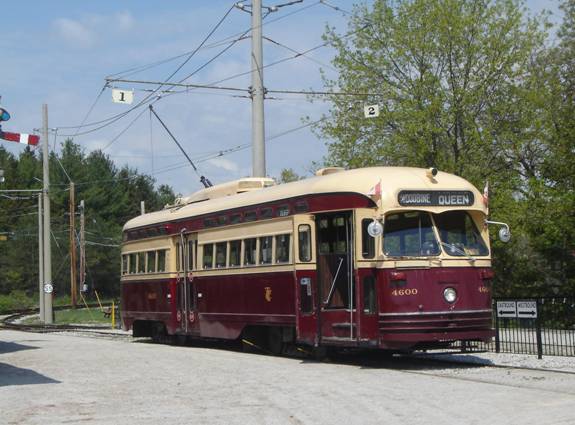
Car 4611 was restored to operating condition in 2007, but it had some electrical bugs. They were slowly worked out and the car ran again in 2011.

Car 4618 was in the worst shape of the three because it suffered a minor underbody fire and had a few parts stripped off it for the other PCCs.

In spring of 2007, 4618 was converted to the “East End Café” which serves ice cream, chips, and pop.

During
the winter of 2025, TTC sent their historic PCCs #4500 and #4549 to

As said previously PCC #4549 is
also at

One project HCRR has been working on for years is car 416 which used to run between Richmond Hill and Toronto. Car 416 was used as a shed until HCRR acquired it in the early 1970s. 416 was the first car to have been restored to running under its own power after being acquired as only a car body.

PCC 4426 was acquired in 1982 and at the time, the car was operational. However, the car deteriorated and is in rough shape. In 2007, the car was given a coat of paint which makes it look better than it really is.

PCC 4684 was originally built for Louisville Kentucky, but was sold to Cleveland before it could have been used there. After Cleveland mostly abandoned streetcar service except for the Shaker Heights line, the car was sold to Toronto and used until 1982. Like 4426, PCC 4684 was delivered to HCRR in operating condition, but has been allowed to deteriorate.

In 1991, HCRR took delivery of PCC 4386. The car was one of 173 PCCs rebuilt in the 1970s. For five years, museum members worked to restore the car to its “as delivered” appearance. However, restoration stopped in 1996 and has yet to restart.

In 2019, HCRR acquired SIG built CLRV #4003; one of six prototype CLRVs. While #4003 is operational, it is sad that 4003’s sister car #4000 was scrapped back in 2017 instead of being preserved. Had it come to HCRR, there would have been two TTC cars numbered 4000!

In addition to #4003, HCRR acquired CLRVs 4010 and 4039 build by UTDC. Until HCRR got a truckload of spare parts in 2020, they temporarily used #4010 for spare circuit boards.
However, HCRR plans to repair #4010 in due time. #4039 will serve as an organ/panel donor and will ultimately be a display car. However, I did ride the car in December of 2019; just over two weeks before TTC retired their last CLRVs including cars older than #4039!


In October of 2019 before the three CLRVs arrived, HCRR acquired ALRV #4204 from TTC. The ALRVs were actually retired before the CLRVs because they were less reliable. #4204 was the first ALRV in revenue service and was one of the last two in service as well!
The TTC was originally going to donate sister car #4207 and keep ALRV #4204 as a historic car but ALRV #4207 temporarily had some of its seats removed for filming a music video! When TTC realized this, they asked HCRR if they could send them #4204 instead. TTC chose to keep #4207 as a historic car.
ALRV #4204 was operational upon arriving at the museum and was able to handle the museum’s turning loops. However HCRR is keeping #4204 on display in Barn #4 instead of operating the car. #4204 is also HCRR’s youngest car being built in 1989.

In
2020, HCRR acquired another CLRV; #4178. #4178 is unique because in summer of
2019, the car was painted in a special livery by a local artist to commemorate
the end of the CLRV era in

Also in 2020, HCRR acquired CLRVs 4040 and 4053 as an additional source of spare parts for their CLRV fleet.


During
the winter of 2020, HCRR also helped store some CLRVs destined for museums in
the


HCRR
stored CLRVs 4024 and 4170 for the “


In 2025, HCRR agreed to store historic CLRVs #4001 and #4089 as well as historic ALRV at the museum.

CLRV #4089 was delivered still with an advertising wrap the car had while in service. It is the first wrapped car at the museum!

ALRV #4207 is also being held at the museum. This was the car TTC originally planned to send the museum until they had removed seats for a music video and send #4204 in its place. I wonder if when it comes time for TTC to take back their historic fleet if they’d take #4207 or convince the museum to swap it for #4204.

In 1999, HCRR acquired Former Toronto M-1 class subway cars 5300 and 5301. These cars were the first two of an order of 36 cars and were the first subway cars built in Canada, but the Montreal Locomotive Works. As the M-1s were being retired, I was hoping 5300-5301 would end up at HCRR which they did.
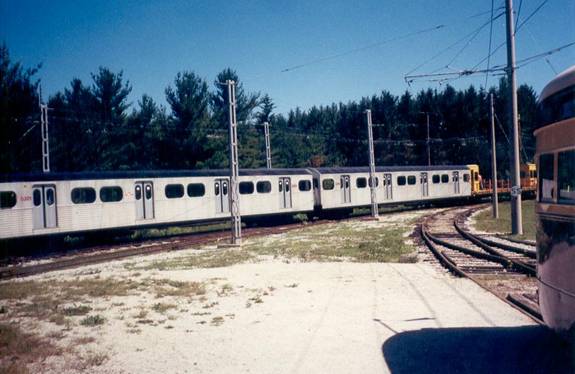
I threw in this photo of 5098-5099 and 5300-5301 because I like it.
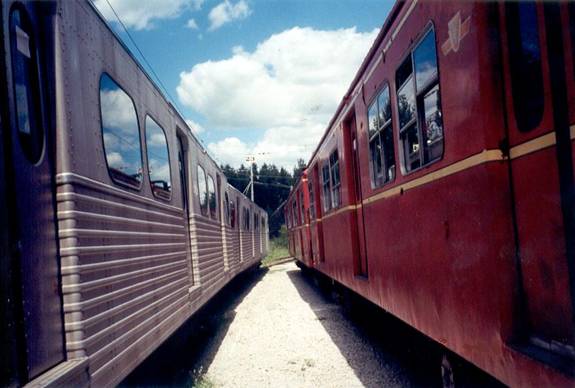
Some of the younger cars in HCRR’s
collection are RT-28 and RT-29 which were built in 1987 using components from
retired

In 2024, HCRR acquired cars 3026 and 3027 from the defunct Scarborough RT. Due to their complexities; they would not be able to run on the museum’s main line.

HCRR had only intended to acquire a single RT car. However they wanted additional parts. TTC was unable to send additional parts so the acquired a second RT car. They had chosen to keep #3026 while #3027 was used for parts. They did keep the cab end for people to pose to be driving #3027 while the rest of the body was scrapped.
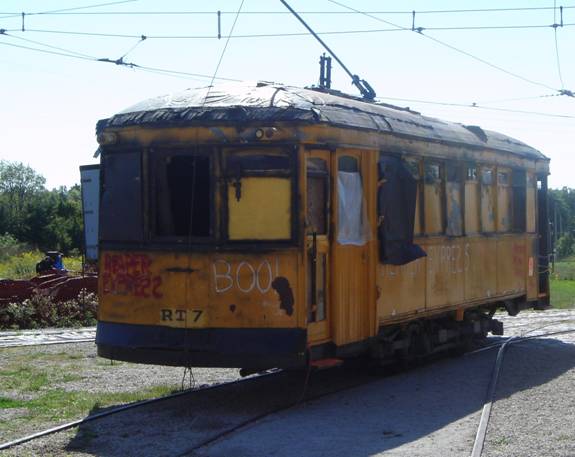
Behind #8058 is the body of former TTC two-door Witt trailer #2395. The two door trailers didn’t last long with TTC and #2395 is the only surviving example
In 2002, HCRR acquired former


Toronto Civic Railways car #55 was the second car HCRR acquired. When HCRR bought it in 1954, it had been converted to a snow scraper and renumbered 2210. HCRR restored the car to nearly new condition. The bus next to it is Ford bus #792. Even though it is painted in TTC colours, it never ran with TTC, though the TTC used similar vehicles numbered as high as 791. The bus was acquired from Kitchener and painted into TTC colours because many movie companies often ask for TTC buses.

Another former Toronto Civic Railways car in HCRR’s collection is TTC rail grinder W-28. The car was converted from car #57 and was extensively modified in the early 1970s.

During Halloween, HCRR uses a car known as the “Reaper Express”. The Reaper Express is former subway grinder RT7. RT7 was converted from former streetcar grinder W-27. It is one of three cars of the type in the collection. When HCRR first started doing the Halloween night show, RT7 would “chase” the streetcars carrying passengers. I was fortunate enough to get a ride in RT7 once. In later years, RT7 has been used as part of a haunted house. RT7 was originally TCR car #53.
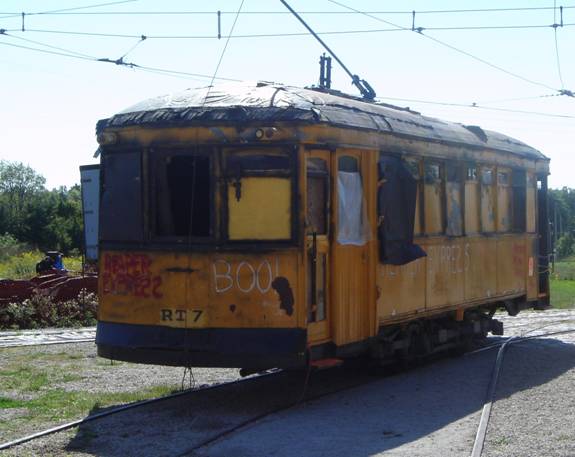
Also in 1999, HCRR acquired Lake
Erie and Northern interurban #797 from the Seashore Trolley Museum in
Kennebunkport, Maine. In exchange for 797, HCRR sent Seashore former Toronto
Peter Witt #2890. That led me to my 2008 trip to

HCRR has two other interurbans:

In 1973 HCRR acquired the body of
Hamilton Street Railways car #521. #521 was part of
In late 2019, a museum member started doing bit of cosmetic restoration on the car though it’s obvious the car won’t be running for a LONG time.

In my mind HCRR should have sent
their fleet of trolleybuses to Seashore instead of 2890 because Seashore has
trolleybus wires to run the buses. As of 2007, HCRR’s trolleybus fleet included
former TTC coaches 23 (which is a body only) and 9348 as well as former
Hamilton Street Railways buses 732, 765, 7801 and 7802. In 2006, HCRR sent
former Toronto Flyer E700b trolleybus #9339 to the
In late 2008, the Illinois Railway
museum stripped former TTC Flyer 9348 for parts for 9339 and

9339 can be seen third from the right. The bus on the right is former HSR #517.

![]()
HCRR has many projects on the go and is fundraising to build a fourth car barn. The project was stalled because the town of Milton wanted HCRR to pay a $100,000 development charge most for facilities the building would not need like sewer pipes and stuff. After months of negotiations, HCRR members managed to reduce the fees to the point that the project can finally go ahead. However, this is pretty ridiculous since they are a not-for-profit organization. HCRR has many more cars, so you will have to visit yourself.